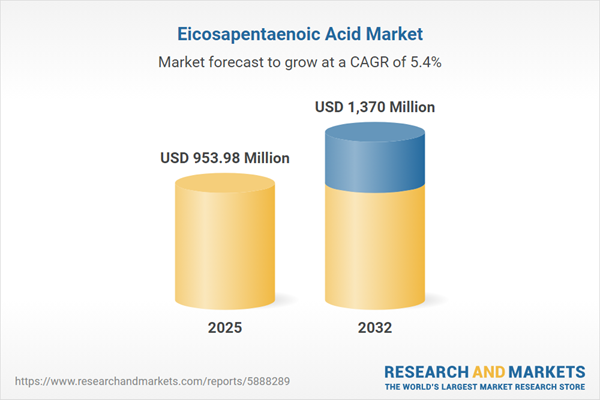Speak directly to the analyst to clarify any post sales queries you may have.
Senior leaders navigating the eicosapentaenoic acid market face a dynamic environment influenced by technological innovation, shifting regulations, and rising expectations for quality and agility. This landscape requires informed strategy to balance sustained growth with evolving consumer and compliance demands.
Eicosapentaenoic Acid Market Snapshot
The eicosapentaenoic acid (EPA) market currently holds a value of USD 904.94 million and is projected to reach USD 953.98 million within one year, reflecting a sustained CAGR of 5.35%. By 2032, sector forecasts estimate a size of USD 1.37 billion. Robust expansion continues to be driven by broad recognition of EPA’s beneficial cardiovascular, cognitive, and anti-inflammatory properties. Nutraceutical and pharmaceutical stakeholders have intensified investment in research and development, advancing product formats from supplements to targeted health applications. Supply chain enhancements and a focus on regulatory adaptation are central strategies for maintaining competitive positioning as market expectations evolve.
Scope & Segmentation: Eicosapentaenoic Acid Market
Effective strategy in the eicosapentaenoic acid sector relies on a clear understanding of its segments and operational scope. Senior executives must calibrate resources with these segments to address health, functional, and sustainability priorities worldwide.
- Application Domains: EPA is deployed in animal feed for aquaculture and livestock, pet nutrition, cosmetic skincare, functional foods, specialty nutraceuticals, and pharmaceutical preparations.
- Form Variants: Product offerings include liquid emulsions, high-purity powders, microencapsulated EPA, softgel capsules, chewable forms, and tablets to meet diverse distribution and consumer needs.
- Source Origins: The segment draws EPA from fish oil, microalgae, and macroalgae, with an emphasis on sustainable inputs and compliance with global standards.
- Distribution Channels: Availability spans direct-to-consumer and third-party e-commerce, retail and hospital pharmacies, specialty health outlets, and major supermarkets, ensuring broad access for institutional and individual buyers.
- Regions Covered: Market activity encompasses the Americas, Europe, Middle East, Africa, and Asia-Pacific. Each brings unique regulatory structures and buyer adoption rates, demanding tailored operational and compliance approaches.
- Key Players: The sector includes BASF SE, Koninklijke DSM N.V., Croda International Plc, Aker Biomarine ASA, Neptune Wellness Solutions Inc., Epax AS, Omega Protein Corporation, GC Rieber Oils AS, KD Pharma Group GmbH, and Polaris Naturals Inc.—each contributing to global innovation and supply.
Eicosapentaenoic Acid Market: Strategic Takeaways for Leaders
- Enhancing traceability and regulatory compliance instills trust and streamlines approval in both human and animal health markets.
- Leveraging production advances such as microencapsulation and precision fermentation supports tailored well-being and functional food solutions.
- Pursuing sustainable sourcing, especially algae-derived EPA, strengthens supply resilience and builds durable supplier networks aligned with environmental objectives.
- Digitalizing the supply chain enables real-time transparency, cuts lead times, and buffers operations from volatility in global logistics.
- Partnering with biotechnology entities and research organizations accelerates new EPA product offerings to keep pace with health and consumer trends.
- Adopting flexible risk controls and business models allows proactive adaptation to differing regional regulatory landscapes.
Tariff Impact: Navigating U.S. Policy Developments
Recent U.S. tariff changes have raised input costs for EPA production, prompting industry leaders to revisit sourcing and manufacturing strategies. The trend is shifting toward increased domestic sourcing and greater use of algae-based EPA to mitigate uncertainty and fortify supply chain reliability under new regulatory and pricing pressures.
Methodology & Data Sources
This report is grounded in rigorous secondary research, comprehensive interviews with experts across the EPA value chain, and in-depth geographic segmentation. Strategic recommendations are based on scenario-driven analysis and case studies tailored to inform executive decision-making.
Why This Report Matters for Strategic Planning
- Prepares leadership to realign strategy with new regulatory demands and rising market standards for eicosapentaenoic acid solutions.
- Supplies a decision framework for optimizing sourcing and resource deployment across prominent global regions to enhance compliance and organizational agility.
- Delivers actionable insight into technology adoption and regional trends, equipping stakeholders to identify priority opportunities for expansion.
Conclusion
Leaders dedicated to innovation and operational advancement will find the eicosapentaenoic acid market ready for sustained opportunity. Emphasizing compliance, sustainable sourcing, and responsiveness will distinguish organizations that achieve lasting competitive strength.
Additional Product Information:
- Purchase of this report includes 1 year online access with quarterly updates.
- This report can be updated on request. Please contact our Customer Experience team using the Ask a Question widget on our website.
Table of Contents
3. Executive Summary
4. Market Overview
7. Cumulative Impact of Artificial Intelligence 2025
Companies Mentioned
The companies profiled in this Eicosapentaenoic Acid market report include:- BASF SE
- Koninklijke DSM N.V.
- Croda International PLC
- Aker Biomarine ASA
- Neptune Wellness Solutions Inc.
- Epax AS
- Omega Protein Corporation
- GC Rieber Oils AS
- KD Pharma Group GmbH
- Polaris Naturals Inc.
Table Information
| Report Attribute | Details |
|---|---|
| No. of Pages | 182 |
| Published | November 2025 |
| Forecast Period | 2025 - 2032 |
| Estimated Market Value ( USD | $ 953.98 Million |
| Forecasted Market Value ( USD | $ 1370 Million |
| Compound Annual Growth Rate | 5.3% |
| Regions Covered | Global |
| No. of Companies Mentioned | 11 |









